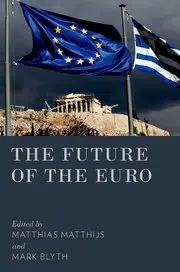A book review by Miguel Otero Iglesias.

The book is divided in the three parts. The first analysis the structural problems of the euro, the second focuses on the effects of the introduction of the euro upon the four biggest economies in EMU: Germany, France, Italy and Spain, and the last looks at the future challenges of the single currency. Kathleen McNamara’s analytically and conceptually insightful first chapter sets the theoretical framework for the rest of the book. She does a terrific job in highlighting the shortcomings of OCA theory. By drawing on the historic examples of the US, Germany, Italy and Switzerland, she demonstrates that for a currency union to be sustainable it needs to be embedded in social and political institutions.
This leads her – rightly – to claim that if EMU wants to survive it needs to become an embedded currency area. So not an OCA but rather an ECA, which necessarily needs to be built on the following four pillars: 1) it needs to have a lender of last resort; 2) a European sovereign debt instrument; 3) a single bank regulator and 4) develop into a transfer union. This is a tall order and the subsequent three chapters by Erik Jones, Nicolas Jabko and Vivien Smith – which focus, respectively, on the three unions that are still missing in EMU: the banking, fiscal and political union – show very rigorously the huge challenges that European policymakers face. The overall assessment on the possibilities of having one day an ECA is bleak, although Jones and Jabko are less pessimistic than Smith.
The subsequent chapters are conceptually rich, empirically sound and extremely thought-provoking, but also highly critical and perhaps overly negative on the past 15 years of the euro and its future developments. Abraham Newman argues that Germany is a “reluctant leader”, which, after the sacrifices of unification, has no appetite to establish the necessary transfer union. Mark Vail compares France to “the middle child of a dysfunctional family”. It wants to be the mediator between an ever-powerful Germany and the small and weaker countries in the Union but is increasingly falling into irrelevance. Jonathan Hopkin laments that the euro has been great for non-tradable services in Spain and Italy but detrimental for their manufacturing sectors. He is convinced Germany’s austerity diet is “doomed to failure” (p.161). Wade Jacoby explains masterfully how Germany is doing too little too late to end the Eurozone crisis, while Craig Parsons and Matthias Matthijs claim that Monnet’s inspired “common rhetoric that European integration moves forward through crisis, though comforting, is dangerously wrong” (p. 231). The only positive assessment comes from Eric Helleiner who argues that the Euro might muddle-through because China has an active interest in having an alternative reserve currency to the US dollar.
While the overall level of analysis is excellent, the volume has a number of weaknesses, absences and unanswered questions. Perhaps the most striking aspect is that the ideational realm is largely under-analysed. This is surprising since a number of the contributors are leading constructivist international political economy scholars. The ‘idea’ of the euro (as the greatest symbol of European political and economic integration, membership of a rich club, and a counter-weight to the Anglo-American world) is absent. For instance, if the Germans are so fed up with assisting the South, why is it that more than 70% of them want to keep the euro? Equally, if the situation in the South of Europe is so dear why is it that the majority of citizens still want the single currency? Greece in particular, which has been in the news non-stop over the past five years, would have deserved a stand-alone chapter in this volume. That the majority of Greeks are still in favour of keeping the euro, despite the hardship they went through, is a puzzle this volume does not solve.
What is also missing is an engagement with the chartalist understanding of money (i.e. a theory of money that sees it as the creation of the state rather than a private sector invention). This is surprising since it was this branch of the literature that has more convincingly argued (even before the crisis) that money is not a neutral medium of exchange to facilitate economic activity but rather a social (and therefore power) struggle between creditors and debtors. It is startling to notice that McNamara’s otherwise excellent critique to OCA theory does not include a reference to Charles Goodhart’s (1998) “The Two Concepts of Money”, arguably the finest analysis of why OCA theory does not tell us anything about the euro.
One also wonders whether the authors are not writing-off France too quickly. La Grande Nation has gradually lost some of its prowess, but this trend can be reversed. France’s productivity, infrastructural and demographic indicators are better than Germany’s, thus it can happen that today’s sick man of Europe becomes tomorrow’s growth engine. The editors conclude that the future of the euro will be decided in Berlin, Rome and Madrid. This is unlikely. Paris still counts, not least because as Sarkozy once said: “France without Germany does not scare anyone, but Germany without France frightens everyone”.
After reading this excellent, but gloomy, book on the future outlook of the euro from Madrid – generally portrayed as one of the capitals of the depressed South – one ends up with the feeling that perhaps some of the IPE literature, especially in the Anglophone world, is repeating the mistakes of the economics profession. As a European Commission paper once put it, the feeling is that “It can’t happen. It’s a bad idea. It won’t last”. In many ways the analysis has become too structural and deterministic. As mentioned, this is partly because the ideational aspects of the euro are missing. This can be observed in Matthijs and Parsons’ chapter. They are absolutely right when they say that this crisis is different from all others, and therefore that Monnet’s old dictum that Europe will be forged by crises, might not apply. But what if the key policymakers, and the populations they represent, believe in this discursive framework? If the great majority of actors think that the only way to achieve an ECA is through crises it can become a self-fulfilling prophecy.
Some of the authors of this volume have convinced us in their previous works that ideas matter and that they can change reality. The ideas that surround the euro might have the same effects. In particular, the fear of what can happen if the euro breaks up is a powerful deterrent. This was last seen during the dramatic negotiations on the third rescue package for Greece when both Merkel and Tsipras realised that Grexit was a no-go.
This post was also published in the Book Review Section
of the European Union Studies Association (EUSA),
as well as on the blog of the Royal Elcano Institute, Madrid.



